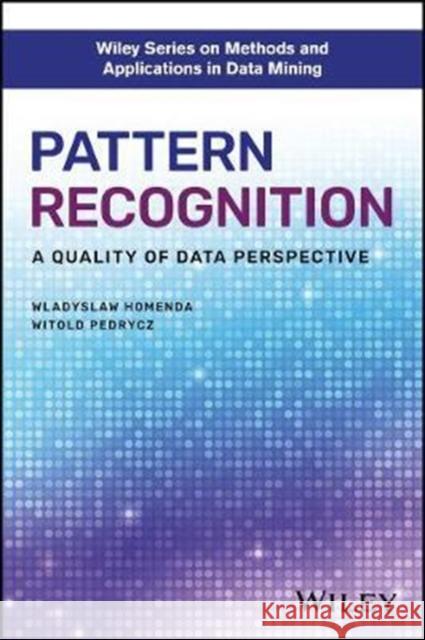Pattern Recognition: A Quality of Data Perspective » książka



Pattern Recognition: A Quality of Data Perspective
ISBN-13: 9781119302827 / Angielski / Twarda / 2018 / 320 str.
Pattern Recognition: A Quality of Data Perspective
ISBN-13: 9781119302827 / Angielski / Twarda / 2018 / 320 str.
(netto: 525,72 VAT: 5%)
Najniższa cena z 30 dni: 548,60
ok. 30 dni roboczych
Dostawa w 2026 r.
Darmowa dostawa!
A new approach to the issue of data quality in pattern recognition Detailing foundational concepts before introducing more complex methodologies and algorithms, this book is a self-contained manual for advanced data analysis and data mining.
PREFACE ix
PART 1 FUNDAMENTALS 1
CHAPTER 1 PATTERN RECOGNITION: FEATURE SPACE CONSTRUCTION 3
1.1 Concepts 3
1.2 From Patterns to Features 8
1.3 Features Scaling 17
1.4 Evaluation and Selection of Features 23
1.5 Conclusions 47
Appendix 1.A 48
Appendix 1.B 50
References 50
CHAPTER 2 PATTERN RECOGNITION: CLASSIFIERS 53
2.1 Concepts 53
2.2 Nearest Neighbors Classification Method 55
2.3 Support Vector Machines Classification Algorithm 57
2.4 Decision Trees in Classification Problems 65
2.5 Ensemble Classifiers 78
2.6 Bayes Classifiers 82
2.7 Conclusions 97
References 97
CHAPTER 3 CLASSIFICATION WITH REJECTION PROBLEM FORMULATION AND AN OVERVIEW 101
3.1 Concepts 102
3.2 The Concept of Rejecting Architectures 107
3.3 Native Patterns–Based Rejection 112
3.4 Rejection Option in the Dataset of Native Patterns: A Case Study 118
3.5 Conclusions 129
References 130
CHAPTER 4 EVALUATING PATTERN RECOGNITION PROBLEM 133
4.1 Evaluating Recognition with Rejection: Basic Concepts 133
4.2 Classification with Rejection with No Foreign Patterns 145
4.3 Classification with Rejection: Local Characterization 149
4.4 Conclusions 156
References 156
CHAPTER 5 RECOGNITION WITH REJECTION: EMPIRICAL ANALYSIS 159
5.1 Experimental Results 160
5.2 Geometrical Approach 175
5.3 Conclusions 191
References 192
PART 2 ADVANCED TOPICS: A FRAMEWORK OF GRANULAR COMPUTING 195
CHAPTER 6 CONCEPTS AND NOTIONS OF INFORMATION GRANULES 197
6.1 Information Granularity and Granular Computing 197
6.2 Formal Platforms of Information Granularity 201
6.3 Intervals and Calculus of Intervals 205
6.4 Calculus of Fuzzy Sets 208
6.5 Characterization of Information Granules: Coverage and Specificity 216
6.6 Matching Information Granules 219
6.7 Conclusions 220
References 221
CHAPTER 7 INFORMATION GRANULES: FUNDAMENTAL CONSTRUCTS 223
7.1 The Principle of Justifiable Granularity 223
7.2 Information Granularity as a Design Asset 230
7.3 Single–Step and Multistep Prediction of Temporal Data in Time Series Models 235
7.4 Development of Granular Models of Higher Type 236
7.5 Classification with Granular Patterns 241
7.6 Conclusions 245
References 246
CHAPTER 8 CLUSTERING 247
8.1 Fuzzy C–Means Clustering Method 247
8.2 k–Means Clustering Algorithm 252
8.3 Augmented Fuzzy Clustering with Clusters and Variables Weighting 253
8.4 Knowledge–Based Clustering 254
8.5 Quality of Clustering Results 254
8.6 Information Granules and Interpretation of Clustering Results 256
8.7 Hierarchical Clustering 258
8.8 Information Granules in Privacy Problem: A Concept of Microaggregation 261
8.9 Development of Information Granules of Higher Type 262
8.10 Experimental Studies 264
8.11 Conclusions 272
References 273
CHAPTER 9 QUALITY OF DATA: IMPUTATION AND DATA BALANCING 275
9.1 Data Imputation: Underlying Concepts and Key Problems 275
9.2 Selected Categories of Imputation Methods 276
9.3 Imputation with the Use of Information Granules 278
9.4 Granular Imputation with the Principle of Justifiable Granularity 279
9.5 Granular Imputation with Fuzzy Clustering 283
9.6 Data Imputation in System Modeling 285
9.7 Imbalanced Data and their Granular Characterization 286
9.8 Conclusions 291
References 291
INDEX 293
W ADYS AW HOMENDA, MSc., PhD, DSc., is an Associate Professor with the Faculty of Mathematics and Information Science at the Warsaw University of Technology, Poland, and an Associate Professor with the Faculty of Economics and Informatics in Vilnius at the University of Bia ystok, Lithuania.
WITOLD PEDRYCZ is a Professor with the Systems Research Institute, Polish Academy of Sciences Warsaw, Poland and Department of Electrical & Computer Engineering, University of Alberta, Edmonton, AB, Canada.
A new approach to the issue of data quality in pattern recognition
Detailing foundational concepts before introducing more complex methodologies and algorithms, this book is a self–contained manual for advanced data analysis and data mining. Top–down organization presents detailed applications only after methodological issues have been mastered, and step–by–step instructions help ensure successful implementation of new processes. By positioning data quality as a factor to be dealt with rather than overcome, the framework provided serves as a valuable, versatile tool in the analysis arsenal.
For decades, practical need has inspired intense theoretical and applied research into pattern recognition for numerous and diverse applications. Throughout, the limiting factor and perpetual problem has been data its sheer diversity, abundance, and variable quality presents the central challenge to pattern recognition innovation. Pattern Recognition: A Quality of Data Perspective repositions that challenge from a hurdle to a given, and presents a new framework for comprehensive data analysis that is designed specifically to accommodate problem data.
Designed as both a practical manual and a discussion about the most useful elements of pattern recognition innovation, this book:
- Details fundamental pattern recognition concepts, including feature space construction, classifiers, rejection, and evaluation
- Provides a systematic examination of the concepts, design methodology, and algorithms involved in pattern recognition
- Includes numerous experiments, detailed schemes, and more advanced problems that reinforce complex concepts
- Acts as a self–contained primer toward advanced solutions, with detailed background and step–by–step processes
- Introduces the concept of granules and provides a framework for granular computing
Pattern recognition plays a pivotal role in data analysis and data mining, fields which are themselves being applied in an expanding sphere of utility. By facing the data quality issue head–on, this book provides students, practitioners, and researchers with a clear way forward amidst the ever–expanding data supply.
1997-2025 DolnySlask.com Agencja Internetowa
KrainaKsiazek.PL - Księgarnia Internetowa









